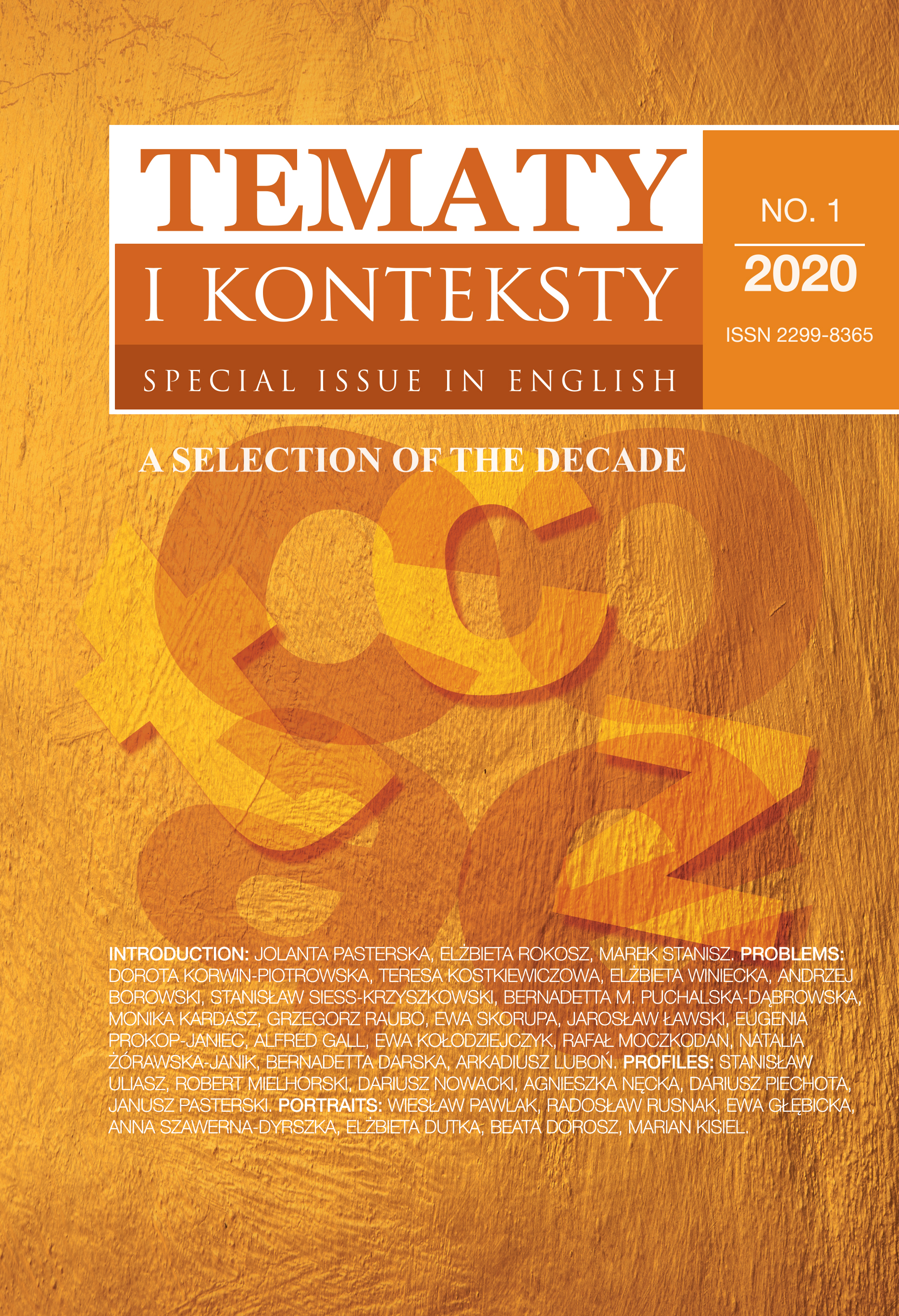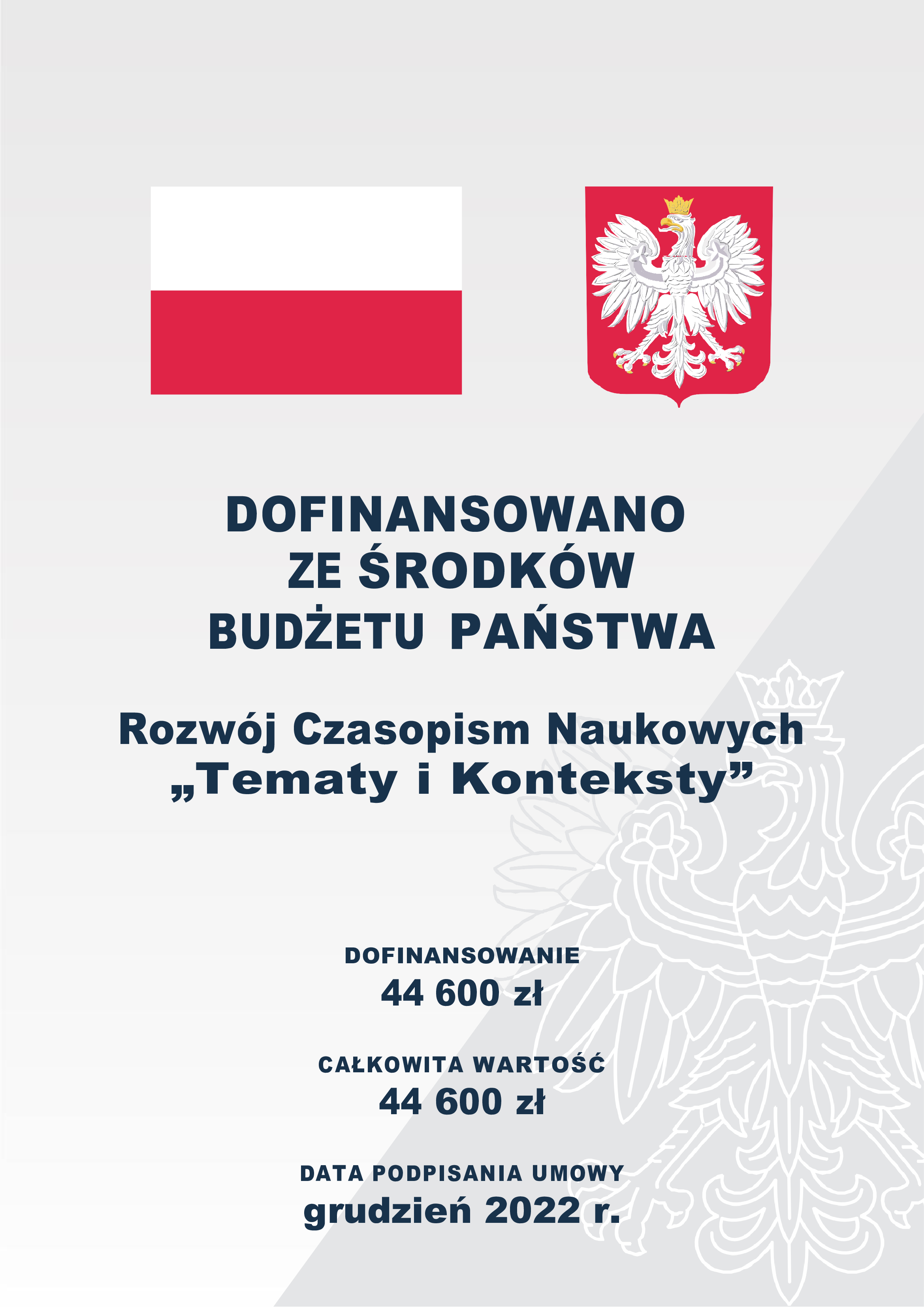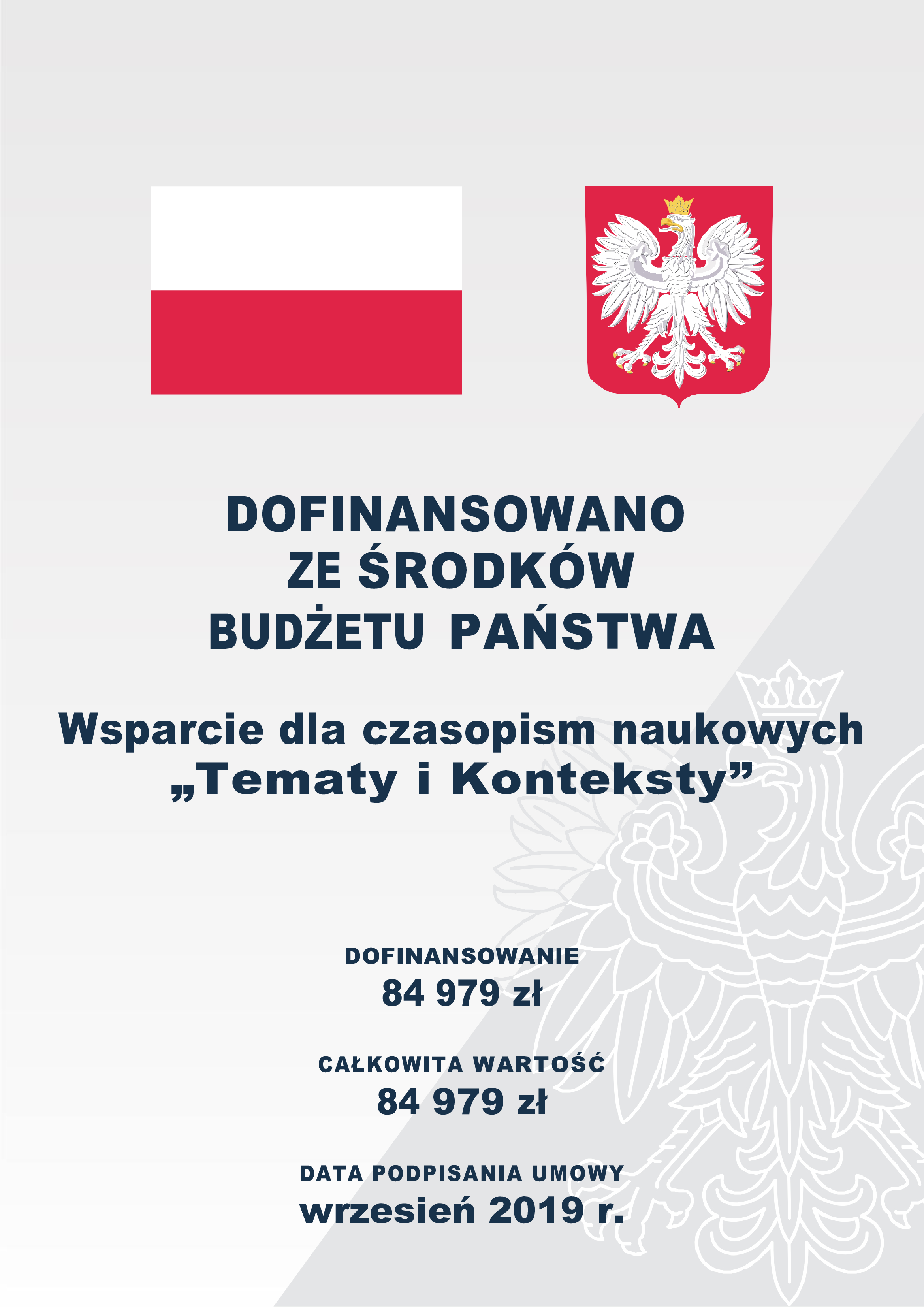The Topos of Childhood in Modern Poetry (1939–1989)
DOI:
https://doi.org/10.15584/tik.spec.eng.2020.19Słowa kluczowe:
childhood in literature, poetry of the second half of the 20th century, childhood of the geographic borderlands, Jewish and war childhood, of the PRL periodAbstrakt
The paper problematises the literary image of childhood in poetry in relation to external historical and socio-political events. The material analysed covers Polish poetry from 1939 – 1989 (a clearly distinguished segment of the historical-literary process). The choice and ordering of the case studies results from the application of two research paradigms: (i) the paradigm concerned with autobiographical motifs, which refers to such topics of 20th century writings as exile (poetry of return by Łobodowski, Wierzyński etc.) immigration (nostalgic [pansentimentalism] and emotionally neutral motifs), Holocaust (motifs of fear, division between now and then, the role of imagination) and (ii) a generation-related paradigm, which allows us to follow the topos of childhood viewed from the perspective of history according to the order of generations entering Polish literature (from the 1920 Generation to the New Wave Groups) up to the succession of consecutive literary trends in the second half of the 20th century (e.g. soc-realism and soc-plans). Poetic texts concerning childhood in the light of history are viewed as records of “rites of passage” operating from the child’s phase of the pre-personalisation area - the child’s sense of being one with the world, experiencing the harmony of being - to the period of personalisation - when history leaves its mark on this period; characterised by the sense of one’s distinctiveness from reality, individual alienation, the need for rationalisation of one’s own existence and the existence of the surrounding reality. The role of history is to lead the child from the pre-personalistic period to the experience of personalisation.
Downloads
Bibliografia
Amiel I., Egzamin z Zagłady, Łódź: Oficyna Bibliofilów, 1994.
Amiel I., Osmaleni, Izabelin: Świat Literacki, 1999.
Antologia poezji polskiej na obczyźnie 1939–1999, selection, edition and introduction by B. Czaykowski, Warszawa–Toronto: “Czytelnik,” Polski Fundusz Wydawniczy w Kanadzie, 2002.
Antropologia słowa. Zagadnienia i wybór tekstów, edited by G. Godlewski, A. Mencwel, R. Sulima, introduction by G. Godlewski, Warszawa: Wydawnictwa Uniwersytetu Warszawskiego, 2004.
Balcerzan E., Poezja polska 1939–1965, part I: Strategie liryczne, Warszawa: WSiP, 1984.
Bielanka-Luftowa M., “Znaczenie terytorium w tak zwanej szkole ukraińskiej,” Pamiętnik Literacki, 1936, issue 2.
Błoński J., “Ofiary i świadkowie. Obraz Zagłady w literaturze polskiej,” Kontury (Tel Aviv), 1996, No. VII.
Burkot S., Spotkania z poezją współczesną, Warszawa: WSiP, 1977.
Burszta W.J., “Nauki o kulturze wobec literatury. Przypadek antropologii,” Teksty Drugie, 2005, No. 4.
“Cena wolności? Dyskusja o języku,” Kontynenty (London), 1960, No. 13.
Chrzanowski M., “Przeżyć i być czystym,” in: Poeta jest jak dziecko. Nowe Roczniki. Antologia, selected and edited by M. Chrzanowski, Z. Jerzyna, J. Koperski, Warszawa: MAW, 1987.
Cybulska M. E., Wacław Iwaniuk poeta, London: Oficyna Poetów i Malarzy, 1984.
Czerniawski A., “Wielopis,” Twórczość, 2004, No. 5.
Dąbrowska M., Uśmiech dzieciństwa, Warszawa: Iskry, 1956.
Dąbrowski M., Literatura polska 1945–1995, Warszawa: Wydawnictwo “Trio,” 1997.
Drewnowski T., Literatura polska 1944–1989. Próba scalenia: obiegi – wzorce – style, Kraków: Towarzystwo Autorów i Wydawców Prac Naukowych Universitas, 2004.
Dygat S., Jezioro Bodeńskie, Kraków: Wydawnictwo Literackie, 1994.
Dzieci, vol. 1, 2, selected and edited by M. Janion, S. Chwin, Gdańsk: Wydawnictwo Morskie, 1988.
Gawliński S., “Szkoła Czechowicza” - poeci awangardy?, Pamiętnik Literacki, 1982, No. 3–4.
Gliksman Ł., *** “Czteroletni,” Kontury (Tel Aviv), 1999, No. X, p. 5.
Głowiński M., “Socparnasizm,” in: idem, Rytuał i demagogia. Trzynaście szkiców o sztuce zdegradowanej, Warszawa: OPEN, 1992.
Iwaniuk W., Zanim znikniemy w opactwie kolorów, selection by K. Lisowski, introduction by J. Kryszak, Kraków: Wydawnictwo Literackie, 1991.
Jarosiński Z., Nadwiślański socrealizm, Warszawa: Instytut Badań Literackich PAN, 1999.
Jarzębski J., “Exodus (ewolucja obrazu kresów po wojnie),” in: idem, W Polsce czyli wszędzie. Szkice o polskiej prozie współczesnej, Warszawa: Wydawnictwo PEN, 1992.
Kaliszewski A., “Brama dzieciństwa,” in: idem, Książę z Kraju Łagodności (O twórczości Jerzego Harasymowicza), Kraków: Wydawnictwo Literackie, 1988.
Kamieńska A., “Poeta środka wieku,” in: A. Słucki, Poezje wybrane, selection, introduction and note by A. Kamieńska, Warszawa: Ludowa Spółdzielnia Wydawnicza, 1982.
Karasek K., Lekcja biologii i inne wiersze, Warszawa: Państwowy Instytut Wydawniczy, 1990.
Kosowska E., Antropologia literatury, Katowice: Wydawnictwo Uniwersytetu Śląskiego, 2003.
Kozioł A., “Wielokrotna podwójność,” Dziennik Polski, 1998, No. 129.
Kresy w literaturze. Twórcy dwudziestowieczni, edited by E. Czaplejewicz, E. Kasperski, Warszawa: Wiedza Powszechna, 1996.
Kryszak J., “Wacław Iwaniuk – poeta ciemnego czasu,” in: W. Iwaniuk, Zanim znikniemy w opactwie kolorów, selection by K. Lisowski, introduction by J. Kryszak, Kraków: Wydawnictwo Literackie, 1991.
Kwiatkowski J., Dwudziestolecie międzywojenne, Warszawa: Państwowe Wydawnictwo Naukowe, 2000.
Leszczyński G., Kulturowy obraz dziecka i dzieciństwa w literaturze drugiej połowy XIX i w XX wieku. Wybrane problemy, Warszawa: Wydział Polonistyki UW, 2006.
Loew R., “Rozpoznanie. Rzecz o izraelskiej prasie w języku polskim,” Kontury (Tel Aviv), 1995, No. VI.
Łobodowski J., Wiersze i poematy, selection, introduction and editor’s note by I. Szypowska, Warszawa: Państwowy Instytut Wydawniczy, 1991.
Łukasiewicz J., “Poemat dla dorosłych – obrachunkowy,” in: idem, Oko poematu, Wrocław: Wydawnictwo Dolnośląskie, 1991.
Łukasiewicz J., “Przestrzeń Świata naiwnego. O poemacie Czesława Miłosza ‘Świat,’” Pamiętnik Literacki, 1981, issue 4.
Łyszak T., “Okruchy dzieciństwa. O dziecięcych świadectwach Zagłady,” Teksty Drugie, 2003, No. 2–3.
Maciąg W., Nasz wiek XX. Przewodnie idee literatury polskiej 1918–1980, Wrocław: Zakład Narodowy imienia Ossolińskich, 1992.
Mielhorski R., “’Jedynie autentyczna teraźniejszość...’ Dzieciństwo w poezji Bogdana Czaykowskiego,” in: Poezja polska na obczyźnie. Studia i szkice, Vol. II, edited by Z. Andres, J. Wolski, Rzeszów: Wydawnictwo Uniwersytetu Rzeszowskiego, 2005.
Mielhorski R., “’Przebisnu rówieśnik’. O cyklu ‘Zabawy chłopięce’ Stanisława Grochowiaka,” Literaturoznawstwo, 2007, No. 1.
Mielhorski R., “Późne elegie Mieczysława Jastruna,” Przegląd Humanistyczny, 2005, No. 2.
Mielhorski R., “Trzy dyskursy o dzieciństwie i przeszłości w poezji Tadeusza Różewicza,” Przegląd Humanistyczny, 2011, No. 3.
Miłosz C., Dolina Issy, Kraków: Wydawnictwo Literackie, 1981.
Miłosz C., “Noty o wygnaniu,” Kultura, Paris 1981, No. 3.
Netz F., “Urodzony w Święto Zmarłych,” Śląsk, Katowice 1995.
Nowosielski K., “’Już czas wracać’ (O jednym wierszu Tadeusza Różewicza), in: idem, Troska i czas. Szkice o poezji i przemijaniu, Gdańsk: Wydawnictwo Uniwersytetu Gdańskiego, 2001.
Olech B., “Zbezczeszczeni, osmaleni, ocaleni,” Kontury 2005, No. XV.
Pieszczachowicz J., “Zagrożone przymierze (O poezji Tadeusza Śliwiaka),” Twórczość, 1996, No. 9.
Problemy tragedii i tragizmu. Studia i szkice, edited by H. Krukowska and J. Ławski, Białystok: Instytut Filologii Polskiej Uniwersytetu w Białymstoku, 2005.
Różewicz T., Niepokój. Wybór wierszy, Warszawa: Państwowy Instytut Wydawniczy, 1995.
Sandauer A., “Poezja tragicznego ładu (Rzecz o Tadeuszu Śliwiaku),” in: idem, Poeci czterech pokoleń, Kraków: Wydawnictwo Literackie, 1977.
Sawicka J., Wołyń poetycki w przestrzeni kresowej, Warszawa: “DiG”, 1999.
Słonimski A., 138 wierszy, Warszawa: Państwowy Instytut Wydawniczy, 1984.
Słonimski A., Popiół i wiatr, drawings by F. Topolski, Warszawa: “Czytelnik,” 1962.
Sokołowska K., “I dziś jestem widzem”. Narracje dzieci Holokaustu, Białystok: TransHumana, 2010.
Stabro S., Literatura polska 1944–2000 w zarysie, Kraków: Wydawnictwo Uniwersytetu Jagiellońskiego, 2002.
Stępień M., Pięćdziesiąt lat literatury polskiej (wprowadzenie), Kraków: Oficyny wydawnicze “Impuls” & “Text”, 1996.
Szaruga L., “Orientacja,” in: idem, Walka o godność. Poezja polska w latach 1939–1988. Zarys głównych problemów, Wrocław: Wydawnictwo “ Wiedza o Kulturze,” 1993.
Szenfeld R., “Pisarze na pograniczu,” Kontury (Tel Aviv) 1996, No. VII.
Szypowska I., Łobodowski, Warszawa: Ludowa Spółdzielnia Wydawnicza, 2001.
Święch J., Literatura polska w latach II wojny światowej, Warszawa: Państwowe Wydawnictwo Naukowe, 1997.
Święch J., “Wstęp,” in: K.K. Baczyński, Wybór poezji, edited by J. Święch, Wrocław: Zakład Narodowy imienia Ossolińskich, 1989.
Urbankowski B., Chłopiec który odchodzi, Łódź: Wydawnictwo Łódzkie, 1991.
Wat A., Poezje zebrane, edition by A. Micińska, J. Zieliński, Kraków: Wydawnictwo „Znak”, 1992.
Ważyk A., Mity rodzinne, Warszawa: “Czytelnik”, 1947.
Ważyk A., Poemat dla dorosłych i inne wiersze, Warszawa: Państwowy Instytut Wydawniczy, 1956.
Wiegandt E., “Austria felix, czyli o micie Galicji w prozie współczesnej,” in: Modele świata i człowieka. Szkice o powieści współczesnej, edited by J. Święch, Lublin: Wydawnictwo Lubelskie, 1985.
Wittlin J., “Blaski i nędze wygnania,” in: idem, Pisma pośmiertne i inny eseje, selection, edition and introduction by J. Zieliński, Warszawa: Biblioteka “ Więzi,” 1991.
Wolski J., Wacław Iwaniuk. Szkice do portretu, Toronto–Rzeszów: Polski Fundusz Wydawniczy w Kanadzie, 2002.
Wołowiec G., Nowocześni w PRL. Przyboś i Sandauer, Wrocław: Wydawnictwo Leopoldinum, 1999.
Woroszylski W., “Dziennik internowania,” in: idem, Z podróży, ze snu, z umierania, Poznań: Wydawnictwo a5, 1992.
Pobrania
Opublikowane
Jak cytować
Numer
Dział
Licencja
Prawa autorskie (c) 2021 Tematy i Konteksty

Utwór dostępny jest na licencji Creative Commons Uznanie autorstwa – Użycie niekomercyjne – Bez utworów zależnych 4.0 Międzynarodowe.




